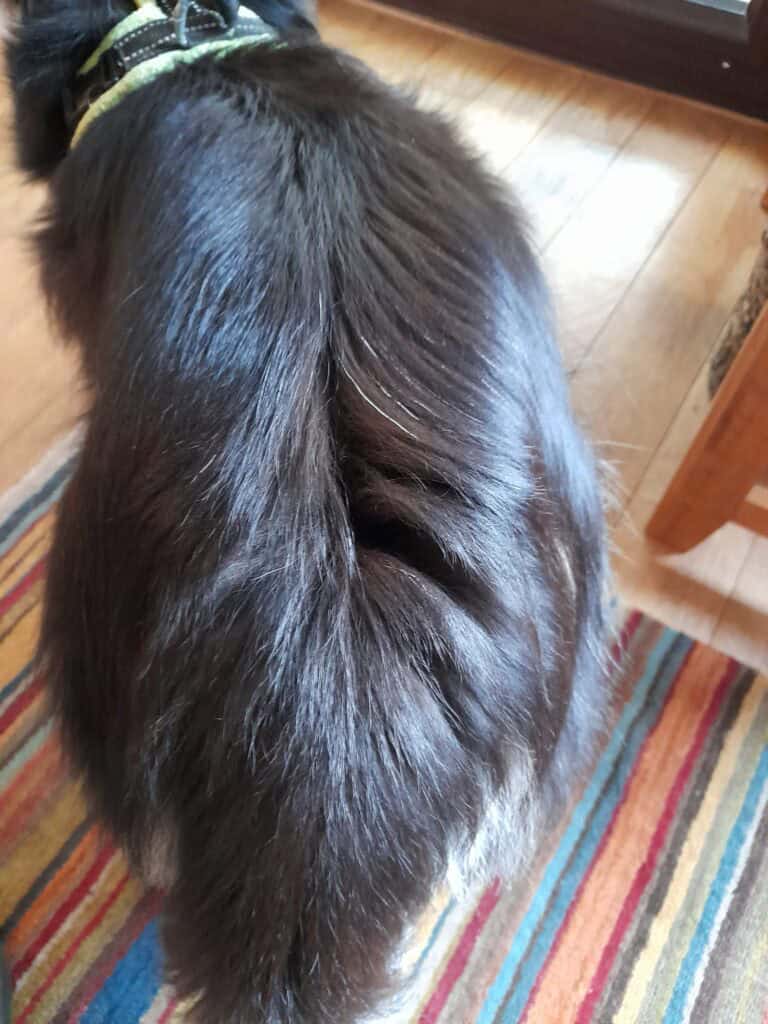Pain might seem like a strange topic to kick off a blog about worry free dog walks…
But more often than you might think, the underlying reason for a dog barking and lunging, or pulling on the lead, is less about training, and more about undiagnosed pain or discomfort.
And I preface all this by saying: no-one wants to think that their dog is in pain. But it’s better to know and be able to do something about it, than be unaware as to what might really be going on for your dog.
I know this from first hand experience
We didn’t realise for a long time that our dog Alice was in pain – hers was muscular pain; tense overworked muscles in her hindquarters, from having to compensate for her missing front leg. She came to us already three-legged, and when we first worked with a trainer, he suggested she might benefit from regular physio to mitigate any issues that might arise over time from her amputation.
Unfortunately our vets at the time told us this wasn’t needed, and she’d only need physio as and when she started to struggle physically as she got older. Sadly, this information was incorrect, and she should have been having maintenance physio from the get go. Years later, the same vets also said there was nothing wrong with her, even after I began to suspect that there was something going on in terms of pain or discomfort.
Isn’t hindsight a wonderful thing? 🤷♀️
I share this story not to vet bash, but to explain that I know exactly what it’s like a) to be oblivious that your dog is in pain, and b) to then struggle to be taken seriously when you do start to have a niggling doubt if everything is ok.
The difference between acute and chronic pain
First, we need to make a distinction between acute pain and chronic pain.
⚡️ Acute pain usually comes on suddenly, often through injury or illness. It’s usually of short duration, and is often resolved when the body heals itself. (But it can also leave lingering effects, and become chronic pain)
⚡️ Chronic pain is long lasting, it’s caused by an underlying issue, and can often gradually get worse over time. And it’s usually harder to identify and diagnose.
That’s not to say that acute pain is more painful than chronic, or vice versa. It depends on the specific pain. The experience of pain also depends on the individual – some dogs can be incredibly stoic about even a very high degree of pain, whereas another dog with exactly the same condition might show us more signs that they’re in pain.
“She can’t be in pain, she’s not limping”
The reality? Dogs will often let you know about acute pain, but they’re usually masters of hiding chronic pain. It’s not so much that they choose to hide their pain, it’s more that they automatically adapt and adjust to live with the pain: if they have discomfort in one part of their body, they will shift their weight and/or move differently to compensate.
For example, a dog with hip joint pain might swing their pelvis from side to side – a butt wiggle – to move their hind legs and get forward motion without having to rotate those sore hip joints.
A lot of the time, the only signs of chronic pain are subtle physical differences that aren’t as pronounced as something like an obvious limp. Or there aren’t any physical signs at all, just behavioural ones.
“He can’t be in pain, he still loves running after his ball”
The reality? Adrenaline and cortisol both mask pain. Dogs are often happy to continue with activities they enjoy and find exciting – such as fetching a ball, playing with doggy friends, or chasing wildlife – even though they’re in pain, because those activities stimulate the release of hormones which override the sensation of pain.
(And that also means it can be very hard to diagnose pain in a veterinary setting, because a lot of dogs are already stressed simply about being at the vets. Increased levels of adrenaline and cortisol can again easily mask any pain and therefore no physical symptoms are exhibited).
“She’s always moved like that / behaved like that, so it can’t be a sign of pain”
The reality? [and remember, I preface this by saying, no-one wants to think that their dog is in pain. Much less that they’ve always been in pain, and that we didn’t know about it]. Sadly, if she’s always done that, it might be because she’s always been in discomfort to some degree. Many chronic medical conditions are developmental i.e. they arise during a puppy’s growth stages. The symptoms associated with the condition may be visible early on in life, or they may become more apparent as the dog gets older.
So if chronic pain is so hard to recognise and identify, what can we do about it?
Physical signs of chronic pain in dogs
There are actually lots of physical signs of potential chronic pain in dogs. It’s just that sometimes they’re quite subtle:
Posture
How a dog holds their body in different stationary positions – such as sitting or standing – and while they’re moving can also give clues. Conformation (which means how they’re put together as a dog) varies by breed, but in principle, dogs should be symmetrical.
When standing, they should be equal weight bearing on all four limbs (unless they’ve only got three 🥰), not favouring one side or the other. And those four legs should be square and parallel to each other – if you’re looking from behind, whether they’re stood still or moving, you shouldn’t be able to really see the front legs, because they should be directly in front of and therefore hidden by the back legs. And likewise when they’re sat, their front legs should be a mirror image of each other, and the same for the back legs, rather than their weight being shifted to one side or the other (sometimes known as a “sloppy sit”).
Believe it or not, how a dog holds their body while toileting can also be a big red flag! It’s not something that many people would consider, but for example, an inability to hold position while pooing, i.e. pooing on the move rather than staying in a stationary squat, or doing lots of little poos at different times can indicate that keeping still in that position is uncomfortable.
Coat patterns and disturbances
A dog’s fur can be affected by tension held in the body. This can manifest itself as differences in texture, colour, and/or direction of fur.
When Alice’s muscles in her back legs were particularly tight, eg after exercise, the fur directly above those muscles wound themselves into little curls and other crazy patterns:

And she also often had some coat disturbances at the base of her spine:

Gait
There is a “correct” way a dog should move – regardless of breed – at different speeds (i.e. walk, trot, canter, and gallop) in terms of how and when they move their legs, in which order and which legs move together. Abnormalities or adaptations or to this can indicate that something is going on.
This could be something like bunny hopping – where a dog moves both of their back legs together, often seen when they set off from standing. Or skipping – where a dog lifts one back leg and hops for a step or two on the other back leg. Or pacing – where a dog moves by lifting their two left limbs at the same time, and then their two right limbs together.
None of these are normal gaits in any dog, and are usually an attempt to offload weight from a painful part of the body.
Other movement
Difficulty or hesitancy in navigating changes in height can also be an indicator of pain – this could be jumping on or off furniture, jumping in or out of a car, or going up or down steps or stairs.
Or the opposite can also be true – hurtling up or down stairs can be a telltale sign that they’re not able to do a controlled slow ascent or descent, because it would hurt to do so.
Ear position
Another little known sign is that tension in one or both ears can often indicate tension elsewhere in the body. If one ear has a tendency to stay more rigid and flops less than the other, this can sometimes correlate with tension in one side of the hindquarters.
(This was something I’d noticed with Alice but not realised the significance. And now I find it fascinating to spot. Before she had physio, her left Now, I find it fascinating to watch – her left ear will be held tighter first thing when we head out on a walk and she’s stiff, and it gradually relaxes and gets more floppy as she loosens up. Likewise if we change terrain mid-walk eg from a hard track onto a sandy beach, her ear will be held tighter again as she has to work harder to move on the soft sand)
Behavioural signs of chronic pain in dogs
There are also lots of behavioural signs of potential chronic pain, that again can often be subtle and therefore easily overlooked. Here’s just a few:
❎️ Avoidance of being touched, or sensitivity to being touched, maybe to only certain parts of their body
❎️ Sensitivity to noises… this might mean they startle when they hear a sound that doesn’t seem that loud to us, or might be full blown panic at certain sounds
❎️ Hyperactive, restless, an inability to settle… if you’re in pain, it’s hard to get comfortable
❎️ Separation anxiety… if there’s other people around you can be distracted from chronic pain, but when you’re left by yourself, there’s nothing to take your mind off it
❎️ Moving away, or even growling, when you sit on the sofa or get on the bed next to them… growling in this instance might make some people’s minds immediately jump to resource guarding: “they’re being possessive about the sofa / the bed”. But if they have some underlying pain – sitting next to them disturbs the soft surface that they’re lying on, which means they get moved out of position, which could cause discomfort. And if this happens a lot, then they will anticipate pain as soon as someone even approaches the sofa or bed, and react accordingly.
❎️ “Stubborn” or “naughty” behaviours… refusing to do something – especially something they have previously been taught, or previously were happy to do – can actually be a reluctance to do something that is going to cause them pain, rather than that they’re ‘misbehaving’ on purpose.
So – there are actually lots and lots of little signs that might be symptoms of discomfort. Of course, that’s not to say that the existence or occurrence of any of the above physical or behavioural signs automatically means your dog is suffering with undiagnosed pain! But it’s enough to consider exploring and investigating further… to start observing your dog a little more closely, and see if you spot any other potential indicators of pain or discomfort.
And if you’ve got a little niggling thought in your head about your dog now? Stay tuned for the next post, to find out what to do next.

